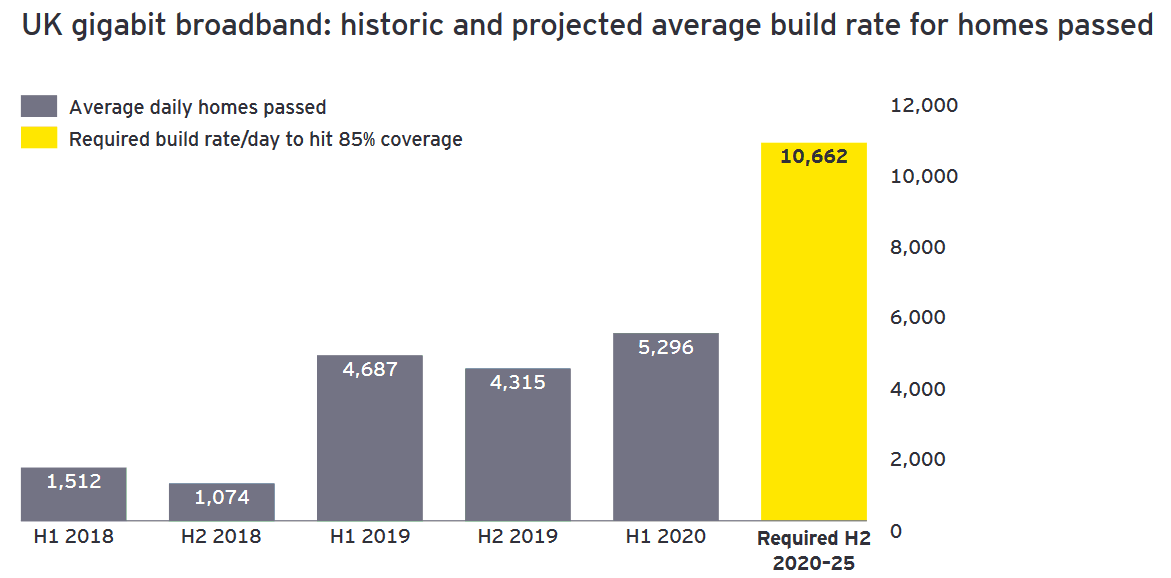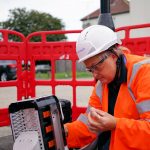EY Report Proposes Ways to Boost UK Gigabit Broadband Rollout

A new report from EY has predicted that the United Kingdom will need to increase the pace of its existing “gigabit-capable broadband” rollout by 85% to 10,000+ premises passed per day in order to meet even the recently reduced 2025 coverage target. But a holistic, end-to-end approach, could help by boosting both supply and demand in tandem.
At present the Government’s £5bn Gigabit Broadband Programme, which has initially only released £1.2bn of this funding, is targeting a minimum of 85% “gigabit-capable” UK network coverage by the end of 2025, but will seek to accelerate that roll-out further to get “as close to 100% as possible.” The private sector is largely expected to reach around 70%+ via commercial projects, while the Government’s investment will thus focus on around 5-6 million premises in the final 20% of the UK (i.e. the hardest to reach areas).
The new report from EY, which also includes a recent survey of 2,000 SMEs (smaller businesses) and 2,500 consumers regarding their attitudes to connectivity and content, claims that the current average build rate for homes passed – the rate at which properties are enabled on gigabit-capable networks – would need to increase by 85% (not to be confused with the 85% coverage figure above), equivalent to more than 10,000 per day, to even meet the recently reduced 2025 target.
Advertisement
We should point out that EY assumes that Fibre-to-the-Premises (FTTP) technology will be used to deliver the “majority of new gigabit capable connections” going forward in the UK, which makes it unclear whether or not they’ve factored-in Virgin Media’s on-going upgrade to 1Gbps+ capable DOCSIS 3.1 technology across their existing HFC and FTTP network (set to reach c.15-16 million premises by the end of 2021 or c.55% of the UK).

The report also confirms that UK businesses are in support of funding being allocated to digital infrastructure. Half (50%) of the respondents believe investment in gigabit connectivity is vital for the economic development of their region post COVID-19, while 48% state that such connectivity would boost their business innovation. Meanwhile 52% believe digital infrastructure is more important to them than physical infrastructure, with only 17% disagreeing.
Otherwise EY states that a holistic approach is needed to drive both supply and demand in tandem with sustained action from Government, regulators and ISPs alike. Despite this Praveen Shankar, EY’s Head of Technology, Media and Telecommunications (TMT) for the UK & Ireland, warned: “While the revised timeframe is more realistic, for that remaining 15% of the population the risk of being left behind is greater than ever. A lack of high-quality digital infrastructure in the regions will limit the opportunity to rebalance and grow the UK economy in years to come.”
Advertisement
EY’s Recommendations
Galvanising demand
Build better gigabit awareness
Providing greater clarity around service availability and quality is critical. Industry and regulators must work together to standardise fibre terminology and remove confusion for customers.
Create better value propositions
Differentiated value propositions are vital to stimulating gigabit broadband upgrade intentions. Articulating what gigabit broadband can provide, such as greater reliability not just higher speeds, is essential.
Ensure switching is simpler
Historically poor experiences of switching providers and upgrading packages have created significant apathy in the market. Frictionless interactions between customers and service providers are critical to simplify the process of switching providers and upgrading packages.
Enable alternative paths for customers to upgrade
Alternative routes are needed to serve demanding customers in remote areas. Community-led business models represent a new way of serving customers with shared infrastructure needs. Yet more education is required in order to avoid complexity.
Supercharging supply
Make planning processes gigabit-ready
Legal access agreements add to the time and cost of infrastructure installations. Simpler arrangements and better information flows across the value chain can help shorten approval times and reduce variability.
Planning success for 5G deployments in some council districts can vary from anything between over 95% to less than 50%.
Ensure access to the right labour in the right locations at the right time
Coordinating a national labour and training response to enable agile access to skilled labour is essential. Government and service providers should collaborate to identify the labour requirements for gigabit rollout and use this knowledge to develop joint training facilities.
The lead time for identifying and training the skilled labour required to deliver FTTP civil works is far greater than the horizon for obtaining funding.
Create more agile wholesale relationships in the gigabit value chain
Regulators and service providers should explore a single enterprise wholesale platform to simplify multi-operator agreements. This can help expand retailer coverage nationwide to ensure effective competition in locations where customer choice is historically limited.
Ofcom’s recent approach has been rightly focused on promoting competition and enabling new alternative networks. Incentivising collaboration between providers is now a must.
Improve network deployment systems, tools, data and processes
More efficient network deployments are critical to maximising return on investment while meeting coverage targets on time. Service providers should use analytics tools to simplify deployment frameworks and ensure greater harmonisation of each other’s data sets.
We should point out that some of the above changes are already happening to some degree, such as improvements in switching between ISPs and planning. Meanwhile others, such as the idea of “working together to standardise fibre terminology” (e.g. stopping hybrid services from using “fibre broadband” in adverts) or improving clarity around service availability and developing a single enterprise wholesale platform, could be more contentious for some operators with differing interests.
Mark is a professional technology writer, IT consultant and computer engineer from Dorset (England), he also founded ISPreview in 1999 and enjoys analysing the latest telecoms and broadband developments. Find me on X (Twitter), Mastodon, Facebook, BlueSky, Threads.net and Linkedin.
« MLL Lights Up Adur and Worthing Council’s Full Fibre Network























































Meanwhile, BT is handing the clawback back confirmed here https://questions-statements.parliament.uk/written-questions/detail/2020-12-08/126868 Process and commercial confidentiality is defeating the objective.
With £900m clawback, there is more likely to be more clawed back than there is invested in rural 2021-22, while as a Capital Deferral BT will be permitted to capitalise and recover these as costs.
I wonder what they think of Virgin Media rolling out FTTP over the last year and CityFibre now doing exactly the same in Weston-super-Mare.
The term gigabit is interesting, most? people will actually sign up for a cheaper, lower speed, product.
VM FTTP: duh boss we got kilometers of coax left. what do ?
I know, we’ll use it to power the ONT of course!!! and we’ll terminate the fibre and then run DOCSIS 3.0 over it.
I mean you can’t make this stuff up. It’s like putting a V8 engine and self driving AI unit into a 1988 Fiat Panda.
Meanwhile…[buffering]… Those of us in rural UK are still on horrifically outdated networks. I get around 5mbps down and [buffering]….less than 1 up. And that’s only cos I pay extra for a business line. Kids out here trying to remote school are struggling, we’re required to conduct more business online and some days it’s just not possible. Would be nice to see the low end of the network getting some love as well as improving the main network.